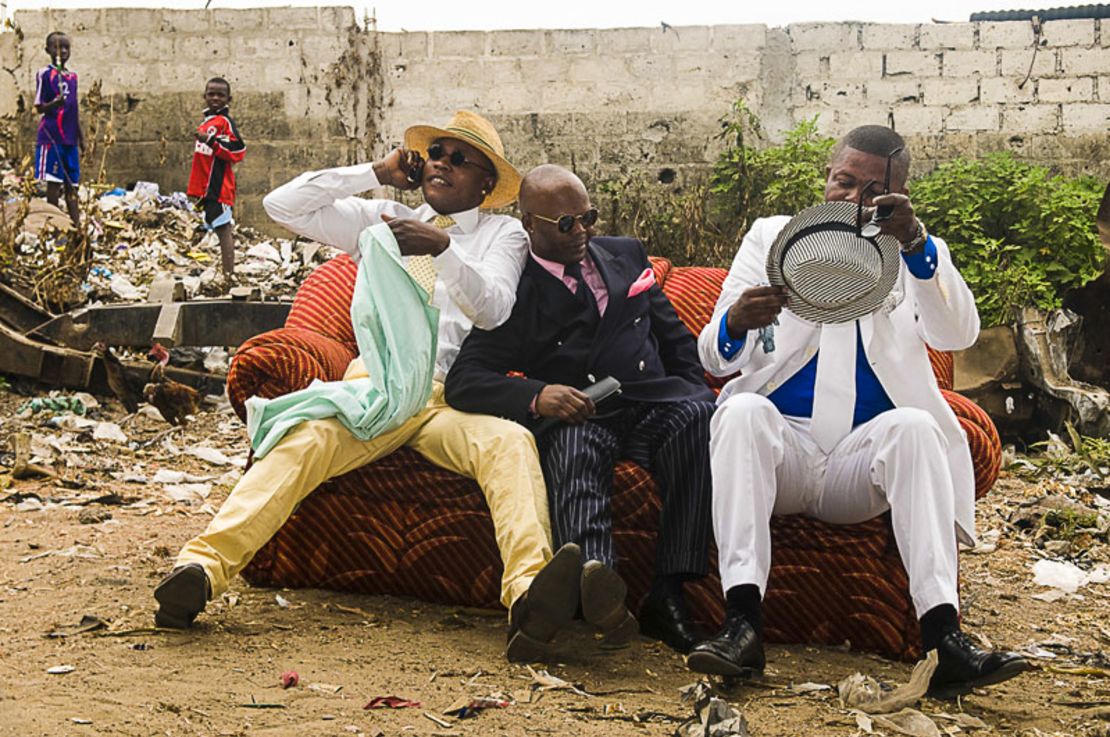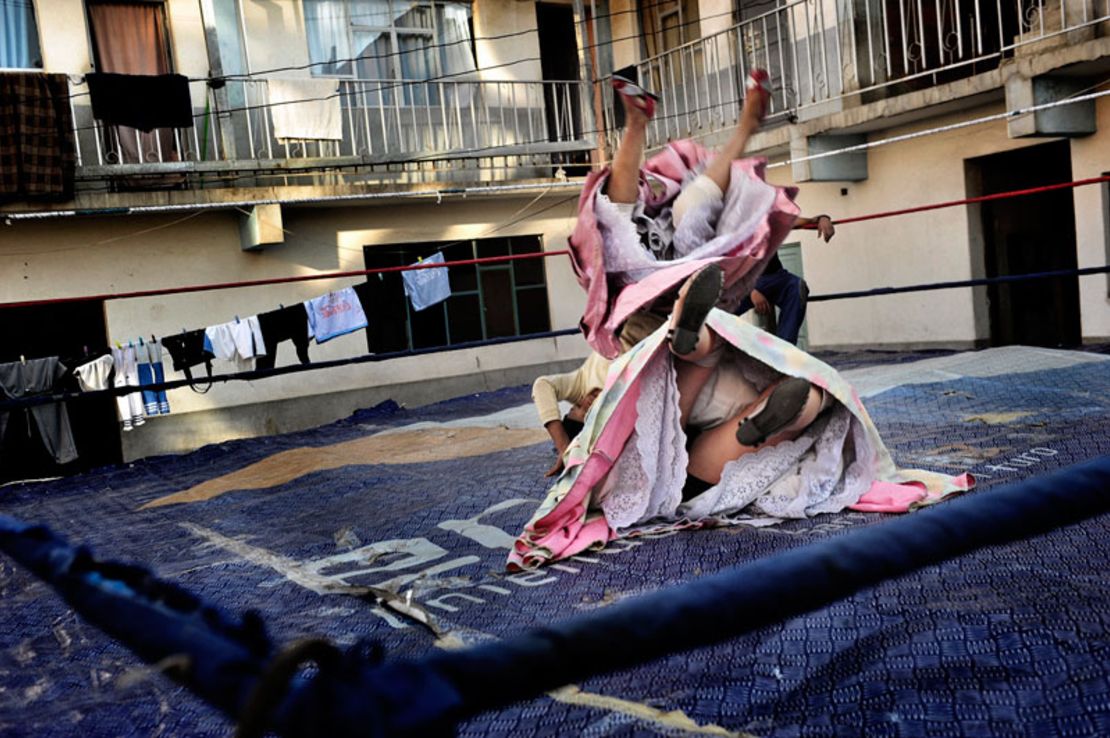Editor’s Note: This is an edited excerpt from a new book called “Fashion Tribes: Global Street Style” by Daniele Tamagni, published by Abrams.
Els van der Plas is the former director of the Prince Claus Fund for Culture and Development and general director of the Dutch National Opera and Ballet in Amsterdam.
Story highlights
Fashion Tribes: Global Street Style, the latest book from photographer Daniele Tamagni, captures the world's most eclectic subcultures
His subjects include Bolivia's female wrestlers, Congolese dandies and Burmese punks
Els van der Plas argues that by either appropriating or rebelling against Western fashion, these groups send a political and personal message
“Tell me the truth, boy, am I losing you for good/We used to kiss all night, but now there’s just no use.” So sings American pop star Solange Knowles, surrounded by well-dressed African men in the music video for her hit song Losing You (2012).
These are Congolese dandies, sapeurs, winding up in a popular music video that won awards for song, video, and styling. Inspired by photographer Daniele Tamagni’s book “Gentlemen of Bacongo,” a photographic classic that portrays the men’s long tradition of public fashion, Solange, with the contribution of Tamagni and Dixy Ndalla, picked up the sapeurs and their style in London and Cape Town. And soon after, African street culture and its protagonists ended up in a video watched by more than 12 million people.
Often, fashion is not created and defined in ateliers, but on the street. Think of postcolonial Kinshasa, London in the sixties, and Tokyo in the eighties. At those times, in those places, being cool was the thing to do. And many of the people who lived there made it their goal to be trendsetters. Some wanted attention, social status, and respect, while others wanted to express their own political views and artistic drives.
In its postcolonial period, during the 1960s and ’70s, Kinshasa, Democratic Republic of Congo, was a hopeful place but desperately poor. Its people had nothing and rebelled against their colonial masters, yet at the same time, they—especially the men—used the colonial look to acquire social status and draw attention.

They exaggerated the Western suit, using clothing to confront their past and gain good standing—honor, respect—in an uncertain future. They called themselves the “sapeurs.” The acronym SAPE stands for La Société des Ambianceurs et des Personnes élégantes (The Society of Ambiance-Makers and Elegant People).
In the sixties, London was relatively rich, and in those postwar years it had a young population that wanted to express its political and social opinions and revolt against the older generation. To that end they created their own look and style, as well as an inspiring music scene to go with it.
In the eighties, Tokyo youth rebelled against the establishment by choosing to spend a few hours a week dressed as rock ‘n’ rollers with transistor radios on a blocked-off two-lane road, effectively denying access for many other people. They lived in a fantasy world that revolved around music, looking good, and being cool.
By dressing up and showing off in flashy outfits on the street, these people got attention, prestige, and power in what were often very poor neighborhoods. At the same time, they inspired other young people to express themselves creatively and independently. And this was frequently accompanied by social and political messages as well
Looking good, being cool, or making a statement (or a combination of the three) and the search for respect and identity are elements shared by these people worldwide. They use the street as a theater, a public catwalk – or a T, as the Africans call it—a boulevard on which to parade. Artistic motives play a major role in this public form of life; at the end of the day, standing out means attracting the gaze.
Reflecting the gaze
What many of these subcultures have in common is that they imitate the West, but with a twist. They look back, as it were. Just as the colonists gazed at them for centuries, they now gaze back. They use, ridicule, criticize, and honor them. Take, for example, the aggressive-looking metalheads who populate the Botswana rock scene—cowboys wearing leather suits and silver buckles in the African heat. Tamagni wants to record the clothing, the style, and the codes of their context and environment.
The metalheads are mostly youths from poor backgrounds who want to show that they are someone. They mix eighties heavy metal and Western cowboy style with African accents, which results in a tough, cool, and intimidating demeanor. As with the sapeurs, it is a matter of appearance, identity, and gaining respect. And at the same time it is a challenging of social and cultural stereotypes and prejudices, especially for the female metalheads, whose appearances tend to violate the established norms.
Some subcultures were picked up by the West, but perhaps in unexpected ways. As previously mentioned, Solange Knowles appropriated the Congolese street style for her music video, which was filmed in various townships in Cape Town with the help of Congolese sapeurs and Tamagni. It is the West looking back to those who look back and then adapt that look to their own taste. Subculture becomes mainstream.
Knowles was inspired by the music video for Janet Jackson’s “Got ‘til It’s Gone” (1997), which, although it was set in Cape Town during the apartheid period, was actually filmed in Los Angeles. Inspired by images from African photographers Seydou Ke?ta (1921-2001), Samuel Fosso (1962-), and J. D. ‘Okhai Ojeikere (1930-2014), we see echoes of those images in the mise-en-scène of her video. Photographs of subcultures inspire fashion, and political messaging becomes a trending topic.
Embracing tradition

On the other side of the world, the opposite is happening. In Bolivia, women are opting for their own tradition. They wear traditional Bolivian clothing and are choosing the same profession as many of their men—wrestling. The male wrestlers dress like Batman and other Western comic-book heroes; the women go for traditional attire. Their motives are the same—to be seen, to establish a place for themselves, to create identity.
In fact, in Bolivia, women used to function on the very margin of the margin; they stood behind their men, who, coming from a deprived background, chose wrestling and made something out of it by dressing as superheroes. Yet it’s the women—proudly in action in the ring and with their men—on which Tamagni focuses. For these women, the code is tradition. The way they look attests to courage and an awareness of history.
Clearly, for many of these groups, a focus on the West is important. However, Tamagni always shows that each culture is unique and significant in its local context. For example, even the Cubans he photographed on the streets of Havana wear T-shirts and other items from well-known brands such as Dolce & Gabbana, Nike, Louis Vuitton, and Armani, despite the fact that the average income there is around twenty dollars per month.
But Cubans have little more than their bodies. As with the sapeurs, their bodies are the only things that they can be certain of, and so they decorate them with Western brands as a show of status and parade them through the streets.
Tamagni photographs these people with respect for who they are, where they live, and what they dream of for the future. He spends days with them to gain their trust, which allows him to take the photographs he wants. And while his subjects’ clothes make a statement, the environment often plays a leading part in the complete image.
A dilapidated house, a backyard with clothing hanging on a wash line, a barking dog running around—it all shows that ordinary life, their reality, is never far away. But, at the same time, it does not stop them from dreaming and hoping for a bright future. You never know, you might end up in an American pop star’s music video.
“Fashion Tribes: Global Street Style” is out now.










